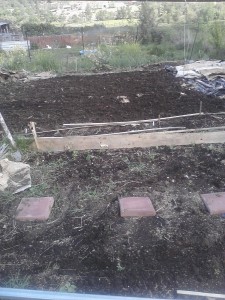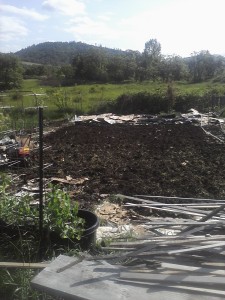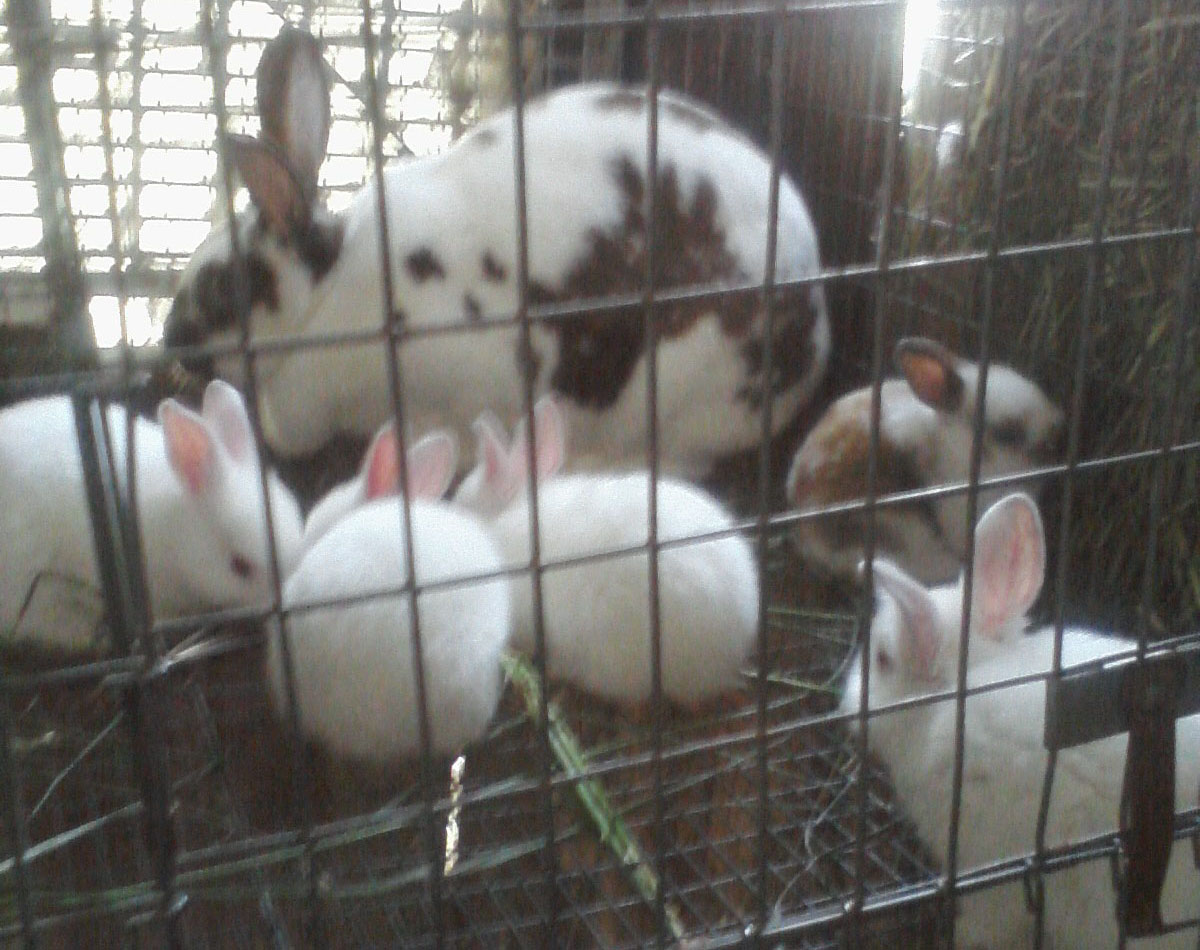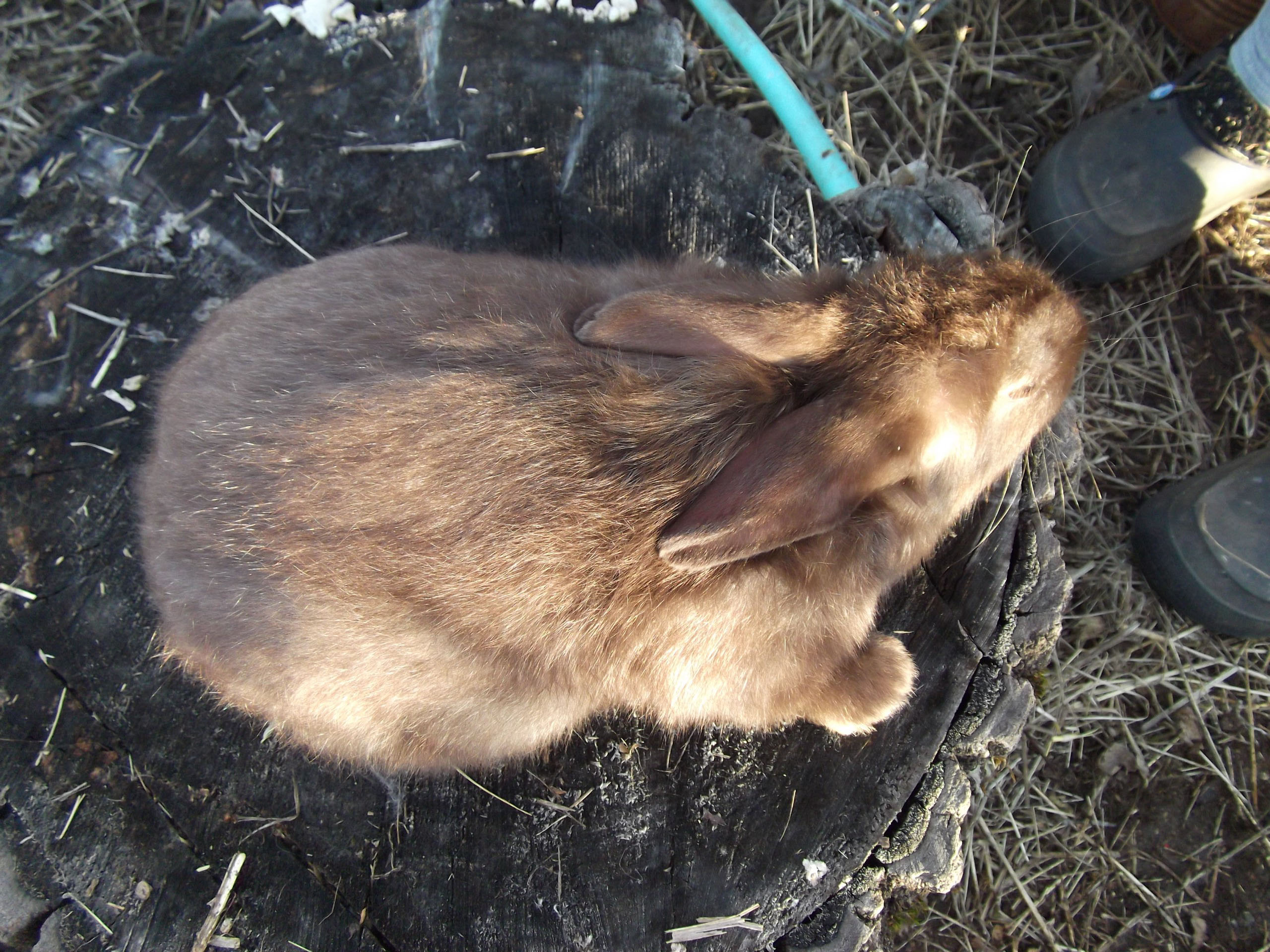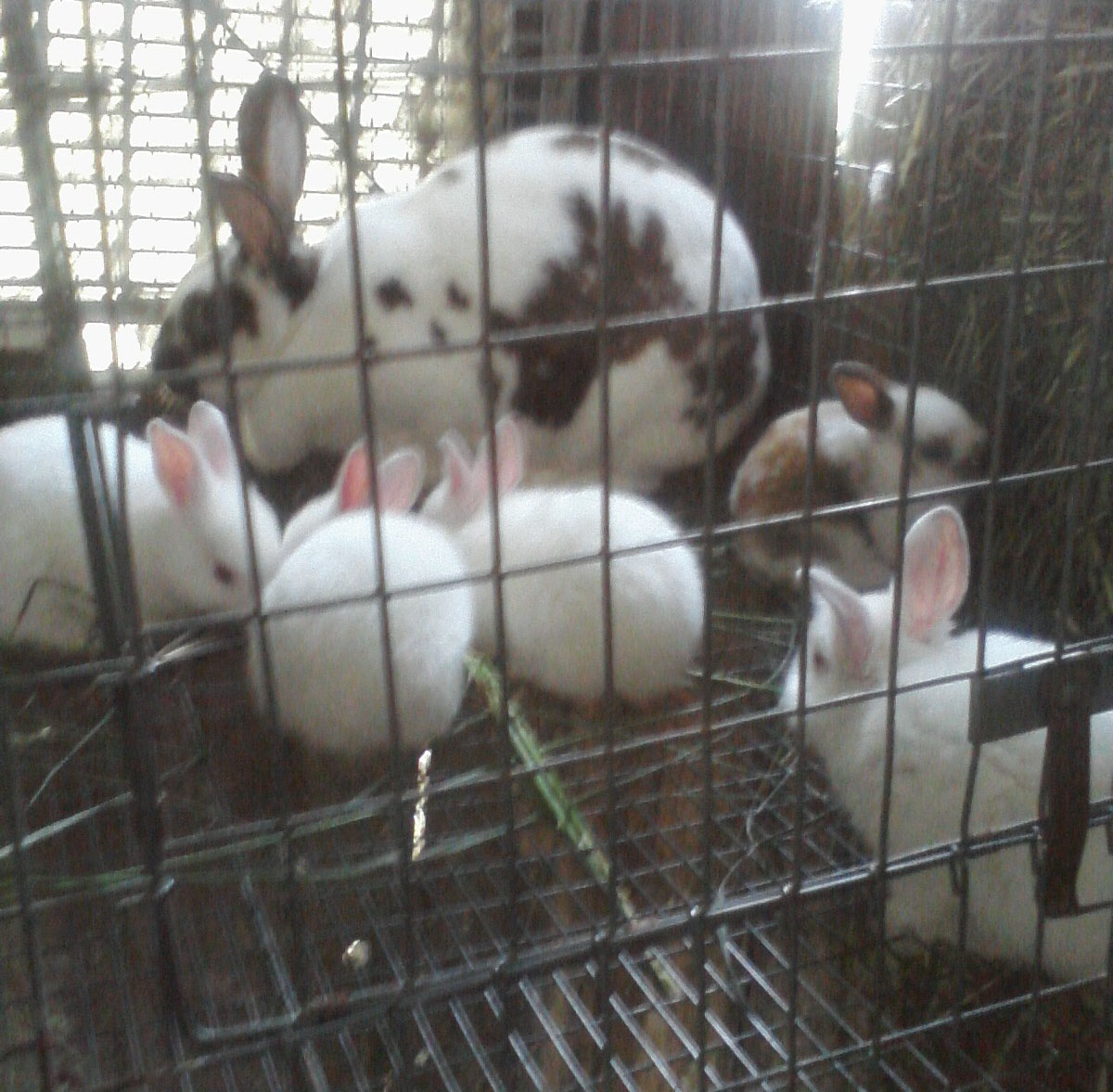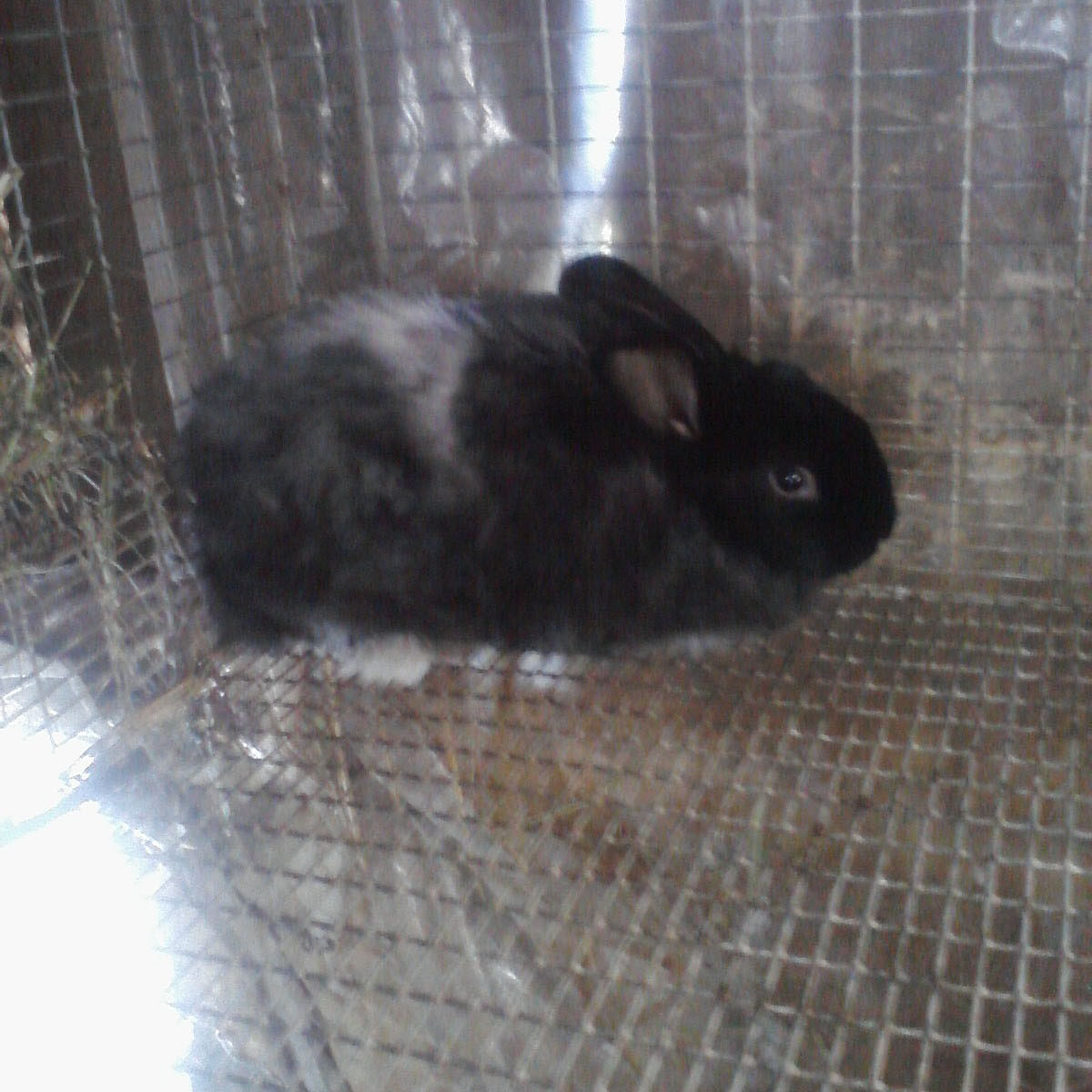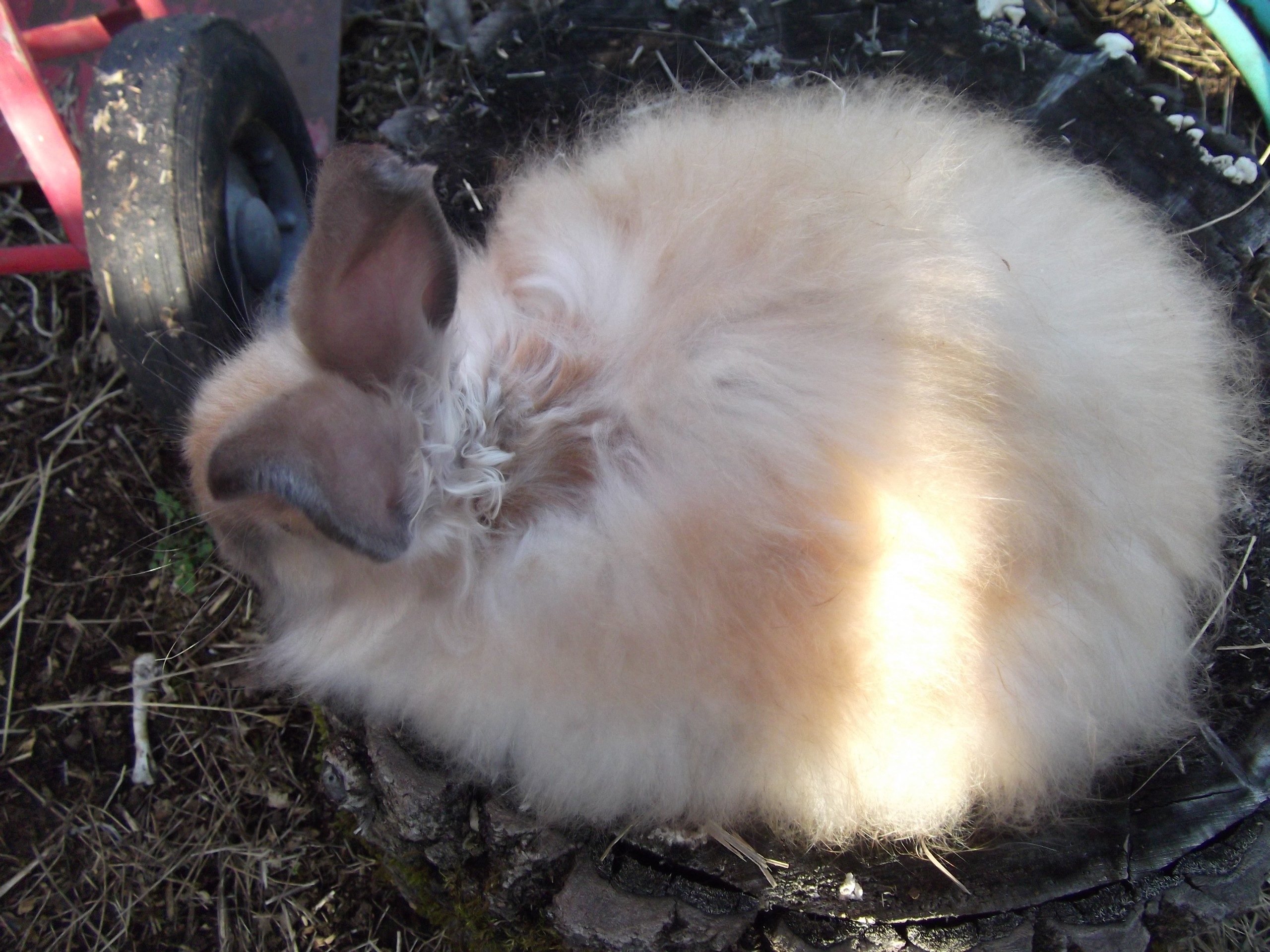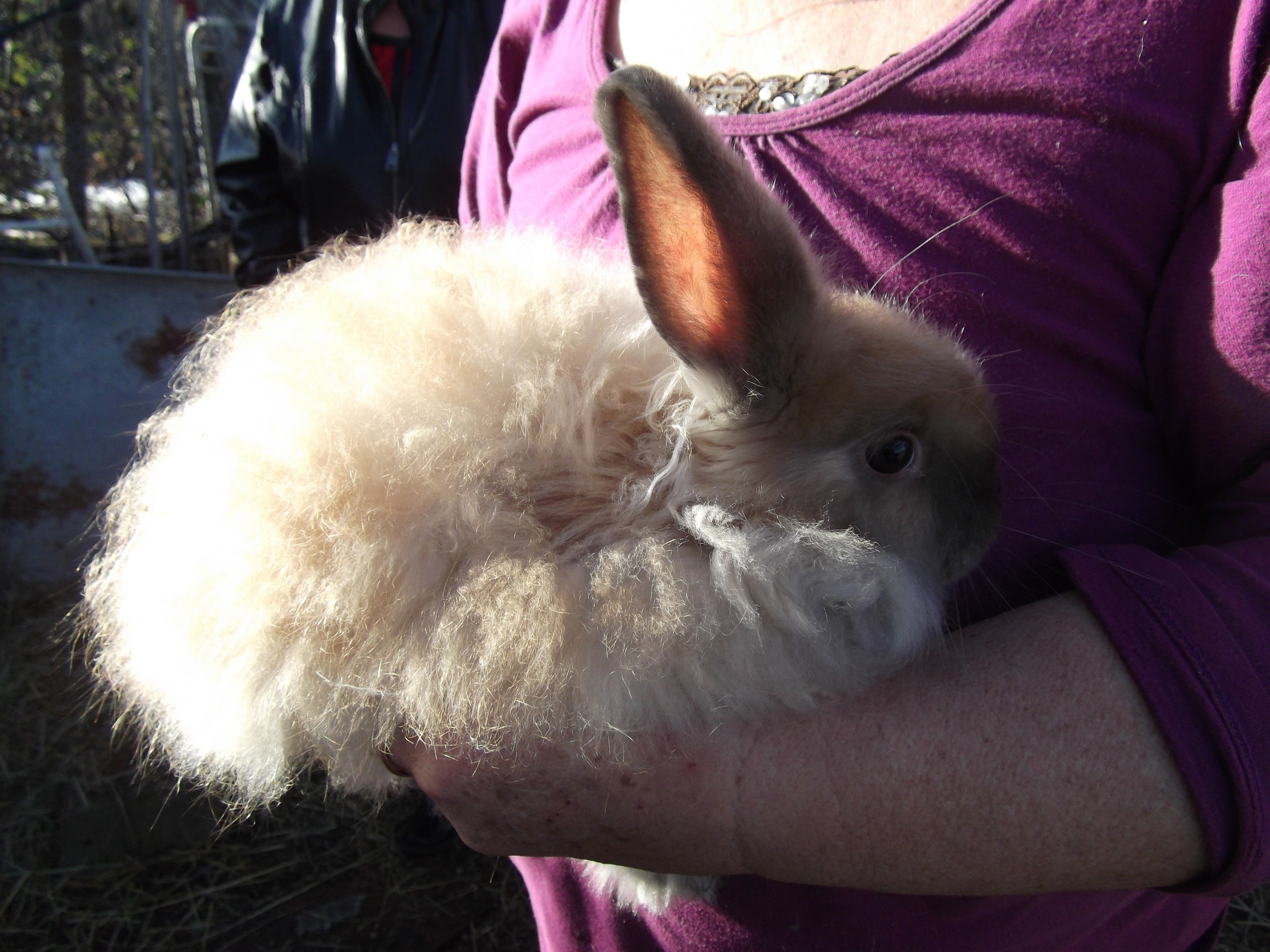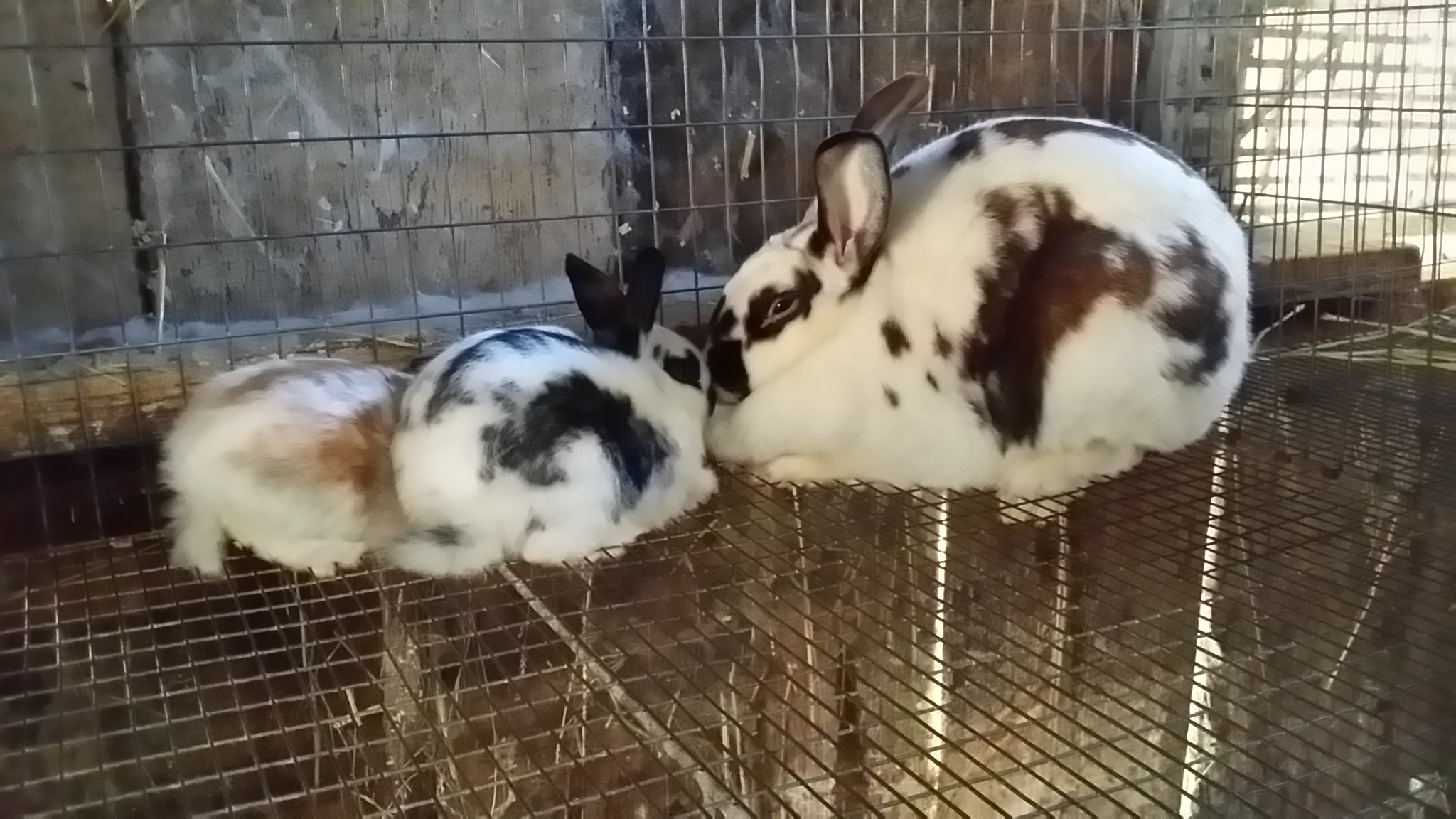The “deep doo-doo”black dirt is the result of sheet mulching with leaves, cardboard and rabbit manure. Cover over with black plastic, do NOT WALK on it and compress the earth. PEEL BACK carefully in Spring, lay wide boards on your pathways. Poke holes with a stick and plant!
IF you had a heifer (female young cow) in your field, and if she could do what a rabbit can do, then at the end of ONE calendar year, you would have NINE FULL SIZE CATTLE in your field, instead of a three-month old calf. A rabbit doubles to triples her weight in cleaned meat EACH TIME she has a litter of bunnies. IN COMMERCIAL PRODUCTION rabbit are bred back when they quit nursing bunnies at 3-4 weeks old. On family farms, they can be more comfortable, have 3 or 4 litters a year, and last for two years producing many litters and lots of manure.
Rabbits love Roses …and other rabbit research
And why you might raise rabbits even if you are vegan
Rabbits produce manure that is arguably the BEST for the gardeners’ purposes. It is ready for use with absolutely no composting: no building bins, no heavy work turning the piles, no trucking in loads of manure from animals who may be heavily medicated. Just park an old wheelbarrow under the cage if you like, wheel to the garden, and dump. If you want to water houseplants or tender seedlings, make a manure tea using a quart or more of rabbit droppings soaked in five gallons of water. Let it sit for a day or two, stir a few times, then strain the tea into your watering can to avoid clogging with the fine fibers. You can dump the fibrous remainder around your berry bushes or other shrubs as mulch.
When the whole of the manure is mixed into soil for growing vegetables, its combination of available nutrients and well broken-down fiber mulch gives incredible results. I’ve gardened in large plastic pots using intensive polyculture methods (basically a major plant and a few smaller ones), and have produced lots of food more reliably than most family gardeners in gopher and deer country like California.
So what’s the cost? Well, wherever you live, there are probably discarded “pet” rabbits at local animal shelters, many of which may be nearly impossible to handle. These animals could be rescued from “euthanasia” and allowed to finish their lives in a cool shady corner of a garden or in- a cage hanging from the north side of an outbuilding, or maybe inside an old horse stall or garage if the winters are harsh. Rabbits die from heat and wind, rarely just from cold temperatures. Choose the large rabbits, as the tiny ones cannot live outside even in milder climates. With some used cages and less than $25 in watering equipment, rabbit manure can be produced right in your own garden.
What does this splendid organic manure cost? Rabbit pellets sell for about $9 per 50-pound bag. Growing your own fodder will be cheaper. You can cut costs by feeding the rabbits organic waste from tree prunings and vegetables, but you must first learn which plants are okay for general use, which for a small portion of diet, and which are deadly, like swiss chard and other oxalic acid plants.
And there would be double satisfaction: at first, saving some small animal lives that would otherwise be wasted. Then later, the great joy of raising top-notch vegetables and fruits, and using less water too!
Why raise rabbits?: Some generalities…
Rabbits are the most economical, labor efficient, and practical way to produce protein. This protein production also has some terrific by-products. I’ve always been very interested in feeding the hungry”it was my motivation from the beginning. It was why I started out as a vegan, and how I’ve become a rabbit raiser. I nearly cried for relief when I did my own conversion rates and realized that with rabbits as clean and resilient as they are, that is, needing no antibiotics, and as well as the manure works, that THIS was the way we could feed everyone a nonchemical diet without chemical “fertilizers,” especially in remote areas where nothing grows but brush, and the soil is dry and depleted. I can grow veggies in almost any soil using rabbit manure, and it holds moisture about as well as those little “water pellet” granules made of cross-linked polyacrylamides, which look like jello.
Rabbit, chicken, and turkey all have similar protein percentages by weight, with beef, lamb, and pork being from 49% less. Rabbit meat has nearly one gram more protein per ounce than chicken, and nearly one gram less fat. It has 15 calories less per pound, and here’s the important one for lots of people: the cholesterol is much lower, even than chicken white meat. AH other meats range from 220-259 mg/lOOg, while rabbit has 164 mg/lOOg. Also noteworthy, rabbit is the richest source of zinc except for oysters, which are bottom feeders, difficult to farm, and very slow growers.
Stock selection
After going to several rabbit shows and studying the various breeds, I came to understand that stock selection was a most important factor. The type of rabbits I raise are called “Satins.” They are a large breed, derived from a genetic mutation in the fur of some New Zealand Whites back in the 1930’s. This mutation caused a hollow hair shaft, which gives a beautiful shine and quality to the color of the coats of this “heavyweight” breed. They come in lots of colors, and are generally calmer and easier to handle without conditioning them into pets than the smaller breeds. It’s similar to dogs…the little ones are hyperactive, the larger ones calmer. Of course, in both animals this is not a rule, but a generality.
The Satin of today is a very different breed from the New Zealands because in order to put color on that fabulous hollow hair shaft the white NZ mutation was crossed with many other breeds, and then the body was reestablished. Sounds amazing, but as the gestation for rabbits is only 30 days, you can go through quite a few generations in a couple years. The Satin is genetically diversified the natural way. Right now in the USA, I have heard that the New Zealand breed has only six breeding lines! That is way too few; we alI understand the disadvantages of monoculture and lack of variety. A majority of the stock in such a rabbitry can develop the same faults, or get sick from the same disease.
Here’s what I did in breeding: I took great stock from very distant strains, and then bred the best I could get. I did not travel the rabbit show circuits, but my rabbits got well known My favorites are the red Siamese. I personally developed that particular color and they have the quality of hybrid vigor. That is when two diverse satins are crossed. and unusual strength, beauty, size, or vigor is noted Though no one talks about it that way, you can see the same results in humans with far-reaching “crosses” like Chinese Puerto Ricans, or dark Africans with Swedes.)
Note: Never cross a frenchlops with their giant heads nor Netherland dwarfs. Their large heads can interfere with the delivery of most production meat rabbits.
Now to set up rabbit-raising equipment
Another important aspect of Raising rabbits is good equipment. Clean new cages are wonderful, but many people start off with used ones and clean them up. A Satin should have six square feet of space, and such a cage costs $35 here in California. There is an easy and cheap way to set up automatic water systems a kind of “drip irrigation” for rabbits, so you never need to fill water bottles, or bleach them from algae. Yippie! Misters can be set up off these systems and turned on when temperatures are too hot. Remember, rabbits die from sun and heat, almost never from cold.
Hang the cages with their floors about waist level. Cages can easily be put onto walls with just a few 16- or 20-penny nails, and a cut sapling or wooden two by- two to stabilize the front edge. They can also be hung by chains from the rafters. The cages can be purchased in groups of two to four, called ‘holes.” If you plan on one pair of breeding rabbits, you can order a three-hole cage” just hang it on a wall, and your rabbitry is finished. Lay some old lightweight interior doors or discarded plywood on top, and complete with feed bags hung around the edges for shade or for wind and rain shelter. My first rabbitry was built along a fence line, using the posts for supports”the fence kept stray dogs out.
If your rabbits live outside, you will need to keep foxes, dogs, and raccoons away from the cages. I did that by using regular stock fencing and a common garden gate with a spring hinge to close it automatically. Outside of that fence, my dogs kept off predators. In fact, one dog who would never stay home was on a line that let her guard both the chicken house and the rabbitry.
She was very proud of her job, well cared for, and praised daily. I never lost any animals in over ten years.
Well, on to details! What most people think they “know” about rabbits is that they have a hot sex life. I think that is very funny, once you really know how it works for this small mammal.
The sex life of rabbits!
RABBITS ARE HIGHLY TERRITORIAL. I would type this ten times down the page if not for space constraints. Never ignore this when raising these small, often fierce creatures. Rabbits, like dogs, cats, and other small mamma!s, mark their territory by scent. Rabbits do two things: they always try to pee in the same place, and they mark things with a little gland located under the chin. This marking is not noticeable to humans, but other animals will sniff these spots. Understanding scent marking gives clues to the animal’s behavior, especially around breeding. Realize that each rabbit owns it’s cage and that space is its only defense other than claws. Rabbis do not usually bite, but they do kick and scratch when threatened.
When breeding, ALWAYS place the female (called a doe) in the male’s cage, or else she will fight him, sometimes to the death. The safest technique is to back the female into the male s cage to avoid her leaping in, leaving claw marks on you from her hind legs. It’s a good idea to wear a long-sleeved shirt when you plan to breed your rabbits. The male (called a buck) mounts the female immediately she enters the cage, and the “act” is finished in less than ten seconds. You can tell when he has finished because he usually falls over onto his side, and this is often accompanied by grunting, spasming, and gripping the female’s body. She does not usually move during this time. A good buck will repeat within two to five minutes, so usually this is allowed in case the female pees immediately and so eliminates the sperm (this is rare).
If the female does not lift her rear end up to allow entry, he bites her on the shoulder (just a grip if he is a good production stud: a nasty puncture wound if he is mean and rough). This bite allows him to stay in place, and causes her to move forward, which means her rear end lifts and then…see details above.
The first time I had a buck six months old that I had raised, he did it nine times in less than 15 minutes and didn’t seem to be able to stop. I was laughing and amazed at his antics. Suddenly I remembered that they can have heart attacks from too much, and snatched the doe out. He never did it more than twice in 10 minutes after that. He was a very noble and reliable fellow, steel and black coat, named “GREYLORD.”
Within 12 hours the doe knows she is pregnant. If you aren’t sure a doe “took” a breeding, then you put her back in the next day. If she is pregnant, she will press her bottom to the floor and vigorously say “nunnnh- aaahhh. ” It sounds like “No way buster, just back off,” and some more aggressive does, who bred instantly the day before, will rear up and strike at the buck with their forelegs. They may even vigorously resist your taking them out of their own cage on the second day, when the day previous they were only shy and skittish
Gestation, birth, and weaning
Gestation is 30 or 31 days. One hopes for eight “kits” because the doe has eight nipples, and most nurse once a day. The milk is very rich. Some can nurse up to 12 young but usually it is better to breed two does at once, especially an older and younger doe, and to foster the young doe’s extra kits over to the older, experienced nurser. Some old does can be kept nursing almost constantly and don’t care how many babies and mixed ages they have. Usually fostering is done within five days of birth (before they get much hair”their eyes open day 8-10).
If you leave 14 babies in the box, the doe gets stressed out, and more than half will die. Sometimes the babies will bite at the doe trying to get more milk, and she will carry them out of the nest box. Sometimes their crying when they don’t get fed or when they get stepped on by the bigger ones will so upset the doe that she will stomp all of them to death, fearing danger in an instinctive way. So, even if you have only one rabbit, look carefully at the bunnies on the first day. If they are even in size, and the next day two are smaller and six are larger, it’s best to remove the two small ones. Otherwise, those will get skinny and rot away, or can get maggots in the summer. A count must be made on day 1 or 2, and checked every day or two thereafter to monitor conditions.
The does have no interest in the bucks, and do not “need companionship.” Sometimes a buck or doe will kill the other when they are confined together and the doe is pregnant. Bucks will try to mount does when they are pregnant, but again, the good production animal will stop when told by the doe, and actually looks kind of surprised, like, “So why are you in my cage then?”
Most bucks will kill the babies if the buck and the doe are left together. This is only done by people who have read nothing about the animals they are keeping, or who don’t realize that one is pregnant, or else by those who think the “experts” are wrong; they are soon very disappointed with their results. (I have heard of one case when this did not happen, just for the record.) In the wild, the doe would fight the buck and keep him out of her nesting territory.
At two weeks, bunnies can run and hide, and at three weeks, the young rabbit can eat and be on its own. However, it is not recommended to separate the babies from the doe until they are five weeks old. If there are six bunnies, move the four largest ones to their own clean cage, and leave the two smaller ones with the mother for another week or so. It is amazing to watch those two grow much faster without competition. This allows the doe to “nurse down” so that she isn’t suddenly without bunnies to nurse, which could cause mastitis, or hardening of the breast tissue and possible subsequent infection.
The transplanted young bunnies will nibble for a day or two, and then suddenly start eating with vigor. It’s a good idea to press the water nipple a few times each day for the first three days until you are sure that at least one bunny is taking water regularly. The others will learn very quickly! Actually, observation of the young rabbits will show that most have started drinking water at three weeks. They look very sweet drinking and washing their faces afterwards at that age. If a production animal or a pet is to be selected from the litter, three weeks is a good time to start handling it once or twice a day, for about ten minutes at first, then gradually increasing up to 30 minutes at six weeks old. It’s good to return the animal to the cage so it can urinate, otherwise it may learn a bad habit”peeing on you to get put back into the cage!
Raising fryer rabbits for meat production
After the young rabbits are caged by themselves, they will still behave as a litter. If you are weaning several litters at a time, you may want to “sex” and separate the rabbits at weaning, bucks in one cage, does in another. Because if the litter develops quickly and you let time slip away from you, you can have a few very young does pregnant at four months old. Also, the young animals will be very rowdy and the bucks will be fighting by that time.
Young rabbits should be fed nearly “free choice” which means there is feed in front of them most of the time. Some people say feed less, and feed twice a day, but I had the best fryers and I fed once a day and packed the feeders full, and the bunnies “dressed out” at three to three and one- half pounds of clean, pink, meat at about 12 weeks old. I’ve learned to never give bucks more than 1 cup of feed per day. It gets stale, they get fat and don’t breed.
Here’s the amazing protein production statistic:
One mature female rabbit produces a litter in 30-31 days. A litter of eight can yield 28 pounds of clean, all-white meat in just 12 weeks of growth. (The animals themselves will weigh over five pounds each.) Therefore, a ten-pound doe can triple her body weight in edible protein in just four months! Rabbit meat is higher in protein, lower in cholesterol, and the highest known source of zinc besides oysters. I’d like to know if anyone has any protein production figures that equal or top this, thanks.
Specifics for the small rabbitry
In all cases below, animals are on the Edstrom water nipple system, which means you only need to put in pelleted feed.
In a large commercial rabbitry, which might contain 200-1000 working does, modern methods in use include a spray water system below each cage which removes all urine and droppings once an hour. The resultant nutrient-rich water is piped directly to adjacent agricultural use. One other system has large trenches under the rows of rabbits, where red worms thrive and are sold as a separate business. A front-end loader is used to handle the worm-filled manure.
About numbers: I had about 25 working adult does and 5-7 bucks when I had my little farm near the coast in Northern California. It took about 50 lbs.”one bag of food a day to keep them all. I made about $100 a week from them, sometimes more if I sold breeders or pets (the famous “BUNNY TRADING CLUB” was beloved of the local children there. Once, it was even on local TV at Easter time!)
Right now I have three does, one senior buck, and one younger buck. This is a family-sized rabbitry. I just started this rabbitry in March of 2001, searching around for my old stock. Luckily a friend had quite a few. I check my rabbits three to four times a week, filling their feeders full to allow free choice feeding. Many people feed their rabbits twice a day, in very small amounts, to keep track of their production costs and how well the animals are eating. I value my time, so I just fill up the feeders (except for the bucks which only get a cup / day).
There are times when you might not want to use my system. One reason could be if you have rats or other predators competing for the food, and the other is if it is raining a lot, because the feed can get damp; lose nutrition, and become unpalatable to the rabbits. Rabbits will not eat dust, so it’s good to use the drop feeders with wire mesh bottoms, so that the dust falls out and the pellets roll down into the feeder inside the cage. A great way to keep the feeders dry is to hang an empty feed bag over the outside. Feed bags have a very thin layer of plastic in between the layers of brown paper.
I keep excellent track of breeding days, usually by keeping a marking pen and a roll of two-inch wide masking tape handy. I write a note every time I put a doe in with a buck, with the date clearly marked. Nest boxes go in five days before birth. Be sure to get the correct size box. The doe must have room to turn around without stepping on the bunnies. I place about three to four quarts of pine shavings in the nest, which is one to two inches deep in the bottom of the box, and two big handfuls of straw, any kind. Never use redwood shavings or redwood resting boards or make nest boxes from redwood. It is toxic to rabbits. They love to gnaw on wood and eat fruitwood twigs and saplings as a natural part of their diet.
Be very careful not to let curious people “check” to see if the baby bunnies have come. The does get very nervous. Only the regular person should be near the rabbits when bunnies are due. And for the next ten days until the eyes are open no one else should touch them. I do sometimes allow a child, sworn to silence, to peer into the nest box, filled with fur and moving gently. The doe pulls all the fur from her nipples and leaves them nude so the bunnies can nurse. She sometimes will rip fur from other parts of her body, until the box nearly overflows with fur. Do not remove any of this, unless temperatures are very high, 90° F. In fact, if you know of an upholstery shop, buy a few pounds of kapok, which is a kind of pillow stuffing from the inside of a kapok tree. It is the best substitute for fur, in case it gets very cold or the doe fails to pull enough fur.
About sanitation: This takes less than two hours a week. Do not allow matted hair and urine or wet droppings to build up anywhere. Use a wire brush to clear away accumulations. Brush the cage floor from both sides. Use water and a wide paint scraper if the buildup is too much for the wire brush. For a really messy cage, put the rabbit in a holding area and scrub the entire cage with soap and bleach, then rinse thoroughly. Generally, healthy animals do not have these problems. Often a temporary case of somewhat wet droppings can be fixed by giving the animals a handful of clean straw, which adds fiber to the diet. A rabbit with consistent diarrhea may be seriously ill, possibly with “wool block” which happens more with long-haired animals, and is similar to fur ball problems in cats. By the way, one strange bit of information: any medicines that are good for cats can also be used on rabbits, such as ear mite medicine, etc. It’s odd because rabbits are completely vegan, and cats are carnivores.
Selling three large fryers, about ten pounds of cleaned meat, brings about $35. So selling three of them can cover feed costs for about six to eight weeks, at $9 for 50 lbs. There will still be plenty of meat to feed your family, and an occasional pet to sell. Financially, this is the most economical way to raise domestic meat. It is also the • most land-conservative, both from the small size of land used to house the animals and the amount of acreage needed to provide food for this valuable source of protein.
With research, which I hope will be done in various Permaculture enclaves all over the world, we could determine just which plants to feed for creating a completely recycled system, needing no cash money at all, past equipment costs. The best hint I have so far (from Bill Mollison) is that the fiber plant called kenaf (seeds available from Texas International Kenaf Center) contains adequate nutrition and needs no preparation at all. The leaves, stalks, and flowers are simply cut and placed in the cages. I have not had opportunity to observe this however, so I don’t know from personal experience just how this fresh food system affects rabbit production and general health. Comfrey can be fed to rabbits as a supplement, though not as a staple. Small pressed blocks of alfalfa are fed by many rabbit raisers, and give rabbits something to gnaw on.
Please share new information about rabbits, especially relating to permaculture. If enough people send me information, I will start an email update quarterly. Also, we could share information about who has rabbits in various locations, and help design a working rabbitry near each permaculture course location.
All of the above information provided for public use.
Copyright 2016
PeaceandPlanting.garden

